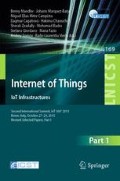Abstract
The IEEE 802.15.4e standard was published in 2012 as an amendment to the Medium Access Control (MAC) protocol defined by the IEEE 802.15.4-2011 standard. The purpose of this paper is to evaluate the Timeslotted Channel Hopping (TSCH) mode of IEEE 802.15.4e in the context of IoT (Internet of Things) regarding environment and changes in application requirements. A simulation scenario of a typical domestic sensor network is designed to evaluate the TSCH mode in a dynamic environment with the presence of WiFi devices. Also are explored the upper and lower bounds in performance gain due to self-learning. The relatively recent release of such standard accounts for its lack of support in network simulators and this work implements the TSCH in the well known open-source network simulator ns-3. This work enables the preview analysis of TSCH networks, decreasing necessary resources and therefore facilitating the use of such networks for social goods such as health monitoring, The results clearly show that the presence of WiFi signals greatly degrades the IEEE 802.15.4e network performance, in terms of throughput, delay and energy consumption. When applying self-learning techniques to avoid degraded channels, the network can properly function and achieves better performance. Also, a significant decrease in delay is also achieved when adapting the slotframe size according to the number of active devices.
Access this chapter
Tax calculation will be finalised at checkout
Purchases are for personal use only
References
I. S. 802.15.4e 2012. Wireless Medium Access Control (MAC) and Physical Layer (PHY) Specifications for Low-Rate Wireless Personal Area Networks (WPANs) Amendment 1: MAC sublayer, IEEE Standard for Information Technology (2012)
T. I. E. T. F. (IETF). IPv6 over the TSCH mode of IEEE 802.15.4e, The Internet Engineering Task Force (IETF) (2014)
Du, P., Roussos, D.G.: Adaptive time slotted channel hopping for wireless sensor networks. In: Computer Science and Electronic Engineering Conference (CEEC) (2012)
Sha, M., Dor, R., Hackmann, G., Lu, C., Kim, T.-S., Park, T.: Self-adapting MAC layer for wireless sensor networks. In: Real-Time Systems Symposium (RTSS) (2013)
ns 3 project. ns-3 network simulator. http://www.nsnam.org/
I. S. 802.11-2007. Wireless LAN Medium Access Control (MAC) and Physical Layer (PHY) Specifications. IEEE Standard for Information Technology (2007)
IEEE, IEEE 802.15 WPANTM Task Group 4 (TG4). http://www.ieee802.org/15/pub/TG4.html. Accessed 09 Apr 2014
Information technology - Open Systems Interconnection - Basic Reference Model: The Basic Model (1994)
I. S. 802.15.4-2006. Wireless Medium Access Control (MAC) and Physical Layer (PHY) Specifications for Low-Rate Wireless Personal Area Networks (WPANs), IEEE Standard for Information Technology (2006)
I. S. 802.15.4-2011. Wireless Medium Access Control (MAC) and Physical Layer (PHY)Specifications for Low-Rate Wireless Personal Area Networks (WPANs), IEEE Standard for Information Technology (2011)
Goldsmith, A.: Wireless Communications. Cambridge University Press (2005). ISBN: 0521837162, 9780521837163
DARPA. Transmission control protocol, Defense Advanced Research Projects Agency, RFC 793 (1981). http://www.ietf.org/rfc/rfc793.txt
Baldo, N., Miozzo, M.: Spectrum-aware channel and phy layer modeling for ns3. In: Spectrum-Aware Channel and PHY Layer Modeling for ns3 (2009)
Crecraft, D., Gorham, D..: Electronics. CRC Press (2003). ISBN: 0748770364
Kraus, J.D.: Antennas. McGraw-Hill, New York (1950)
Vilajosana, X., Wang, Q., Chraim, F., Watteyne, T., Chang, T., Pister, K.S.J.: A realistic energy consumption model for TSCH networks. IEEE Sens. J. 14(2), 482–489 (2014)
Author information
Authors and Affiliations
Corresponding author
Editor information
Editors and Affiliations
Rights and permissions
Copyright information
© 2016 ICST Institute for Computer Sciences, Social Informatics and Telecommunications Engineering
About this paper
Cite this paper
Pacheco, L., Vermeulen, T., Pollin, S., Solis, P. (2016). Evaluation of TSCH/IEEE 802.15.4e in a Domestic Network Environment. In: Mandler, B., et al. Internet of Things. IoT Infrastructures. IoT360 2015. Lecture Notes of the Institute for Computer Sciences, Social Informatics and Telecommunications Engineering, vol 169. Springer, Cham. https://doi.org/10.1007/978-3-319-47063-4_25
Download citation
DOI: https://doi.org/10.1007/978-3-319-47063-4_25
Publisher Name: Springer, Cham
Print ISBN: 978-3-319-47062-7
Online ISBN: 978-3-319-47063-4
eBook Packages: Computer ScienceComputer Science (R0)

